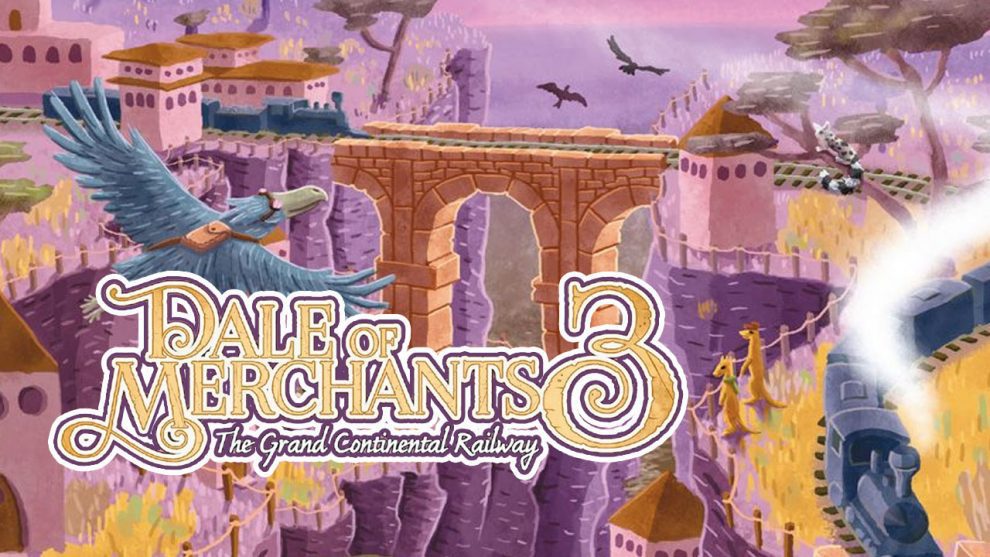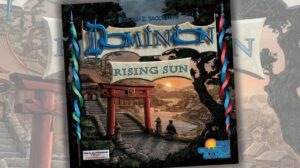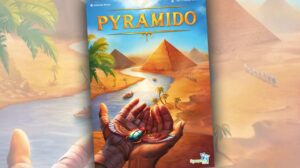Disclosure: Meeple Mountain received a free copy of this product in exchange for an honest, unbiased review. This review is not intended to be an endorsement.
Disclaimer 1: A prototype copy of Dale of Merchants 3 was reviewed under lockdown conditions during the 2020 Covid-19 pandemic and therefore could only be played at the 2-player count.
Disclaimer 2: I am already a fan of the Dale of Merchants series. Check out my reviews of the original Dale of Merchants and Dale of Merchants Collection to know more.
The Dale of Merchants series entered the world way back in 2015 with ‘Dale of Merchants: The Guild of Extraordinary Traders’. Since then Sami Laakso and Snowdale Design have released two standalone sequels and a mini-expansion. Confusingly, this makes Dale of Merchants 3 the fourth main release in the series, but it’s the third small box game, with Dale of Merchants Collection being very much a big-boxed anomaly. All four games are playable by themselves or can be combined for a greater choice of animalfolk each game.
Series history and nomenclature out of the way let’s get down to the latest release.
Dale of Merchants 3: The Grand Continental Railway
For veterans of the series, Dale of Merchants 3 adds six new animalfolk decks with a new die, market board and junk cards. Skip down to the next section to find out what’s new.
For those who’ve not encountered the series before, the Dale of Merchants (henceforth DoM) games are deck-building games in which players are animalfolk merchants racing to complete their stalls by placing cards in front of them in stacks of ascending order. All cards in the game have a value from 1 to 5 and the first person to place a stack of cards worth exactly 8 wins.
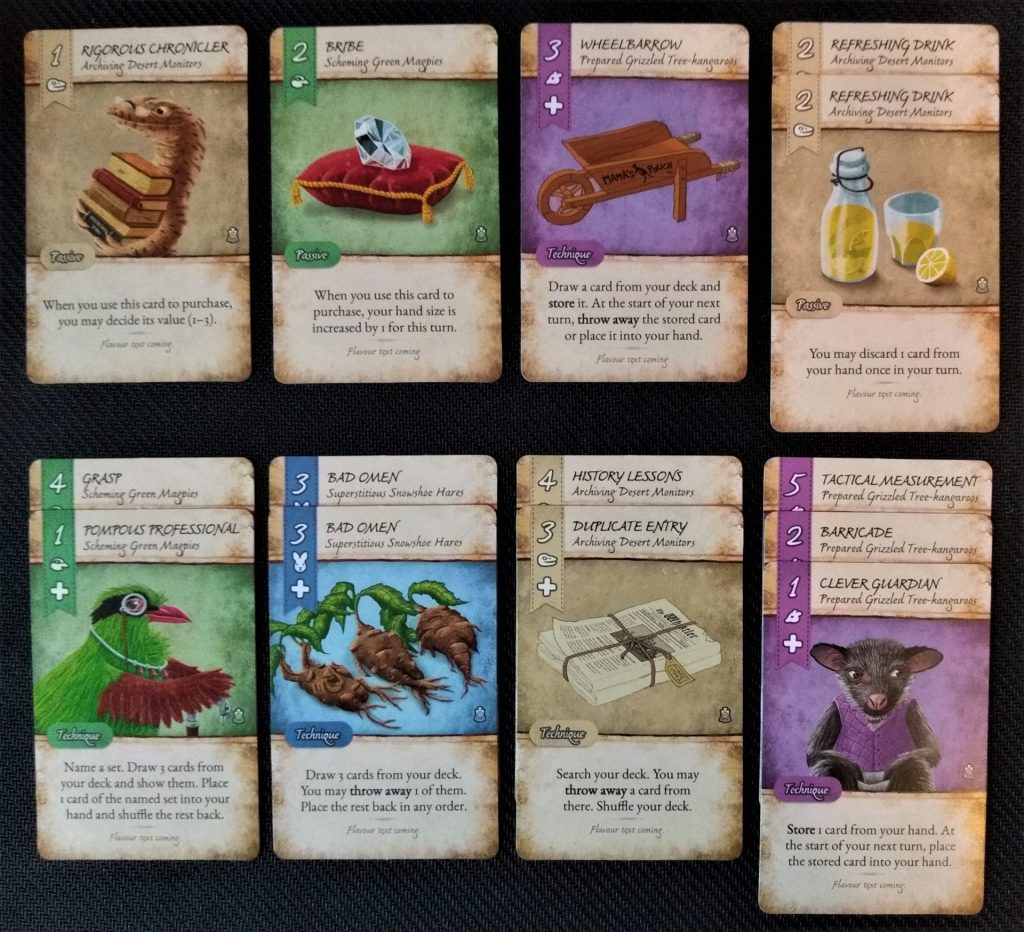
In deck-building games players start with their own small decks of low-valued cards and are able to buy better cards during the game to improve the worth or power of their decks and achieve the goal of the game. It’s a mechanic used in hundreds of games, with notable examples including Dominion, Clank!, and Great Western Trail.
Yet the DoM series rips up the traditional deck-building formula – almost every aspect is tweaked, creating a game that feels very different to anything on the market. For instance, bought cards go directly into your hand and unplayed cards aren’t discarded at the end of your turn (changes to the deck-building formula later seen in 2017’s Valletta). All these different tweaks combine to give you phenomenal control over what cards are in your hand and means the combos you create feel earned rather than the result of a lucky draw from your deck.
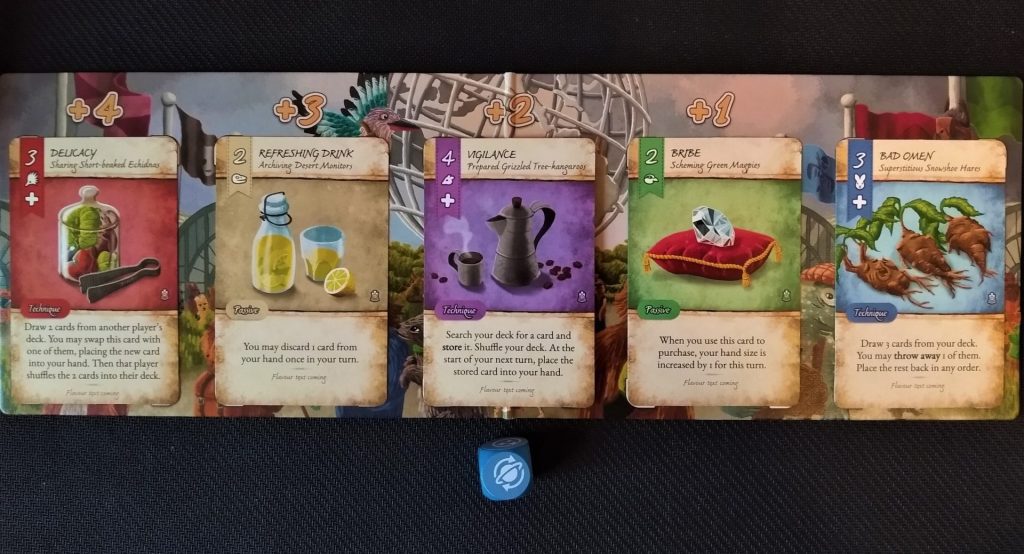
Throughout the game you’re faced with a constant tug of war between deck-building and deck-dismantling. When do you want to keep cards for their value and special ability, and when should you sacrifice them to build a stack and inch closer to victory? It’s common to end the game with far fewer cards than you started with, making
For a more detailed summary of the mechanics of DoM, check out my earlier review of the original Dale of Merchants here.
Getting to know the Animalfolk
Before each game a number of animalfolk decks are selected (one more than the number of players) and shuffled together to form the pool of cards with which you’ll be playing. Animalfolk decks are like themed suits, each consisting of 15 cards with their own abilities that revolve around a certain playstyle. Some animalfolk manipulate how you can build stacks, some allow you to mimic another player’s cards, some let you be utterly devious, some just plain mean, and so on. The result is that two games using different animalfolk decks can feel very different, depending on the playstyle of those decks.
With 21 animalfolk decks previously released there’s already a ton of variation and replayability to the series. DoM3 adds another 6:
Archiving Desert Monitors – These hardy reptiles are excellent at moving cards between their hand, deck and discard pile. For the beginner there’s plenty of intuitive cards that let you pull off turns that feel smart. For the veteran the Monitors may not be as showy as some of the more distinctive animalfolk in the series, but they’re one of those very useful decks that are quietly effective and can give a nice balance to a game. Subtle but effective.
Discontent White-headed Lemurs – ’Discontent’ might be the most fitting descriptive term for an animalfolk yet. With the Lemurs you can throw away cards like there’s no tomorrow, often replacing them just as fast. For newcomers and veterans alike, the Lemurs are a lot of fun and if you enjoy stripping your deck of the chaff then they’re excellent. The Lemurs give you a lot of flexibility with how your deck behaves over the course of the game. Ruthless machines for keeping your deck lean.
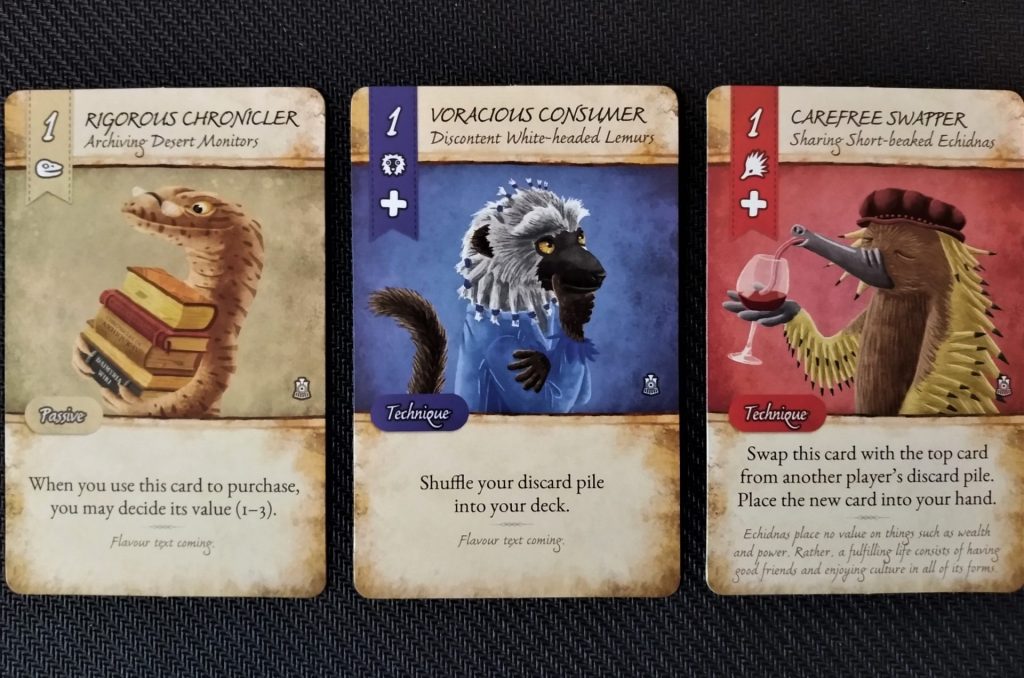
Sharing Short-beaked Echidnas – ‘Sharing’ sounds nice, friendly even. But it sure doesn’t feel like that when your opponent has taken one of your best cards and left you with something they didn’t want. The counter-balance is that most of the Echidna cards swap themselves, meaning that you can try to get your card back if you wish. If you want interaction but aren’t especially confrontational then the Echidnas make a nice compromise. Sharing is caring… sort of.
Scheming Green Magpies – Magpies take, take, take, but they need to know what it is they want first. You’ll have to name a card or guess its value before you can steal from an opponent. The Magpies mean you have to pay attention to what the other players are up to if you want to use them well, although sometimes it’s fun just taking a punt and guessing a number! It’s a mean animalfolk deck but the Magpies are no blunt instrument – you need to be smart to use them effectively. Thieves with strict standards.
Superstitious Showshoe Hares – Every DoM game has an animalfolk deck that uses dice rolls and the Hares are DoM3’s. You’ll be rolling the die to take cards from different areas of the game and a couple of the cards are fantastic. In a series first, one of the sides of the die gives an optional reroll meaning that you aren’t always stuck with something you don’t want. It must be said that the reroll symbol could be more obvious but that may simply be the prototype die I’ve been using. The cards that don’t use the die are fun too. Sometimes you make your own luck… sometimes you don’t!
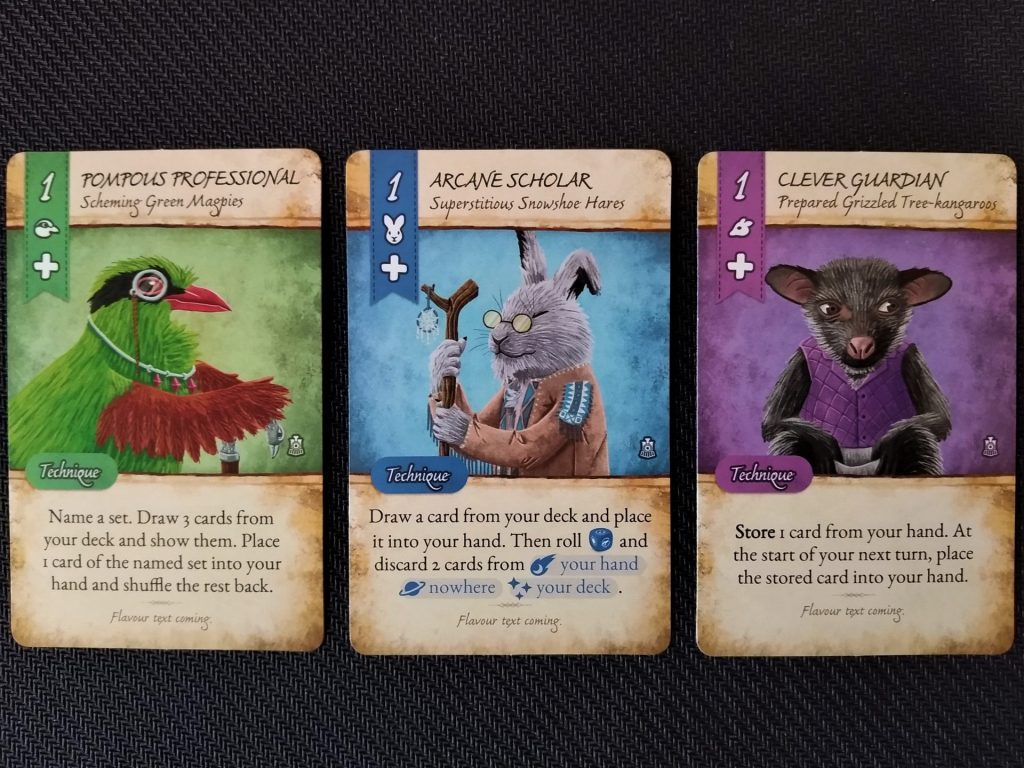
Prepared Grizzled Tree-kangaroos – The Tree-kangaroos introduce a new mechanic – Storing. When you store a card you reserve it for your next turn, protecting it from the thieving of the Echidnas and Magpies. And if light-fingered animalfolk aren’t in the game then storing allows you to hold back a card for your next turn without it affecting your hand size. They can be a bit trickier to use effectively but they’ll allow you to pull the right cards together at the right time if you can manage them. For those who like to have something up their sleeve.
Animals United
DoM3 captures the same magic as the games before it. The push-pull of building your deck and building stacks combined with the race to win means you’re kept on your toes from the moment someone places that first stack. There’s an energy to the game rarely found in deck-builders and interaction is built into every aspect, regardless of what decks you use. You’re completely invested in what your opponents are up to.
The game feels very different depending on what animalfolk are in play. A game with the Echidnas, Magpies and Hares is tonally distinct from a game with the Monitors, Lemurs and Tree-kangaroos. One feels a bit wild with cards flying all over the place, the other more restrained and considered. I will say that there are two or three animalfolk in DoM3 that if combined can result in an awful lot of shuffling. It’s only a minor thing but it can feel a bit much if you end up shuffling your deck multiple times in a single turn (and a kudos to you if, like my wife, you can do that with a baby asleep on your shoulder).

As with previous games, when you first play with a new animalfolk deck you’ll spend a fair proportion of the game reading card texts – whilst clear there can be a lot of different card types in play (a 2 player game has 18 different cards) with their own effects and values. However, once you know the cards better games can whiz by and downtime in a 2 player game can be minimal. It helps you want to know what your opponent is up to so you can steal their cards!
Due to the coronavirus pandemic I’ve not been able to test DoM3 at more than 2 players, but having played all the previous entries in the series I’m confident it would work similarly well at 3 and 4 players. The Echidnas, in particular, seem well suited to more players, giving you plenty of options for some of their more situational effects. In contrast, the Magpies are the perfect ‘nasty’ deck for 2 players with their need to keep track of what cards your opponent has bought and played to be able to guess what’s in their hand or deck.
Comparisons with Previous DoM Games
For newcomers to the DoM series, I think DoM3 is a great place to start. Designer Sami Laakso has clearly developed his skills over the past 5 years, the central mechanics of DoM3 feel smoother than ever. The core experience hasn’t changed but everything is just a little more polished. DoM remains an excellent framework and there are some great cards and combinations to be found in this new release.
All the small box DoM games are designed to provide a similar balance of playstyles and DoM3 feels as strong a starting point as any of them. If pushed I’d say that DoM3 is slightly less intuitive than the straightforward decks of DoM and perhaps a touch more interactive than either DoM or DoM2. That being said, I’ve entered the statistics from the animalfolk selector cards into a spreadsheet and the means and spreads of interaction, nastiness, complexity and randomness across the games aren’t obviously different so what do I know! For those that aren’t a fan of outright aggression I’m happy to report that there’s nothing here as abrasive as DoM2’s Intimidating Dwarf Crocodiles!
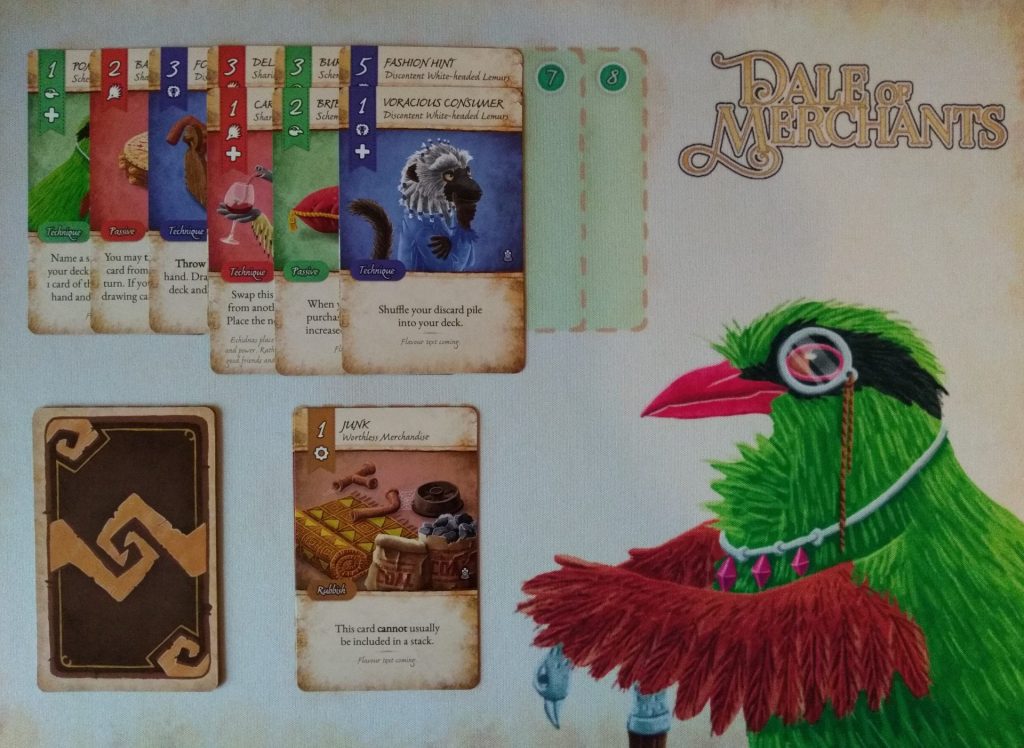
For the DoM veteran I can say that DoM3 is another great addition to increase the variation in the game. There are some real series card highlights here, regardless of your preferred playstyle. That being said, I feel like DoM Collection has spoiled me a little – my first couple of games with DoM3 felt a touch underwhelming. But then not every game has animalfolk whose powers vary depending on the time of day or cards that you have to buy back once you’ve used them. DoM3 is not as obviously outlandish as DoM Collection but I’m happy to say that repeated plays with DoM3 erased all traces of disappointment as I got to know the animalfolk better.
If you own all the animalfolk decks already you’ll find that there’s some similarities between deck colours – with a total of 27 animalfolk decks it would be difficult not to have multiple instances of blue for instance. The shades are fairly distinct and the iconography is clear (plus each card has its animalfolk name on it) so it shouldn’t be a problem unless you’re playing under very low light conditions (in which case you might struggle to read the card text anyway).
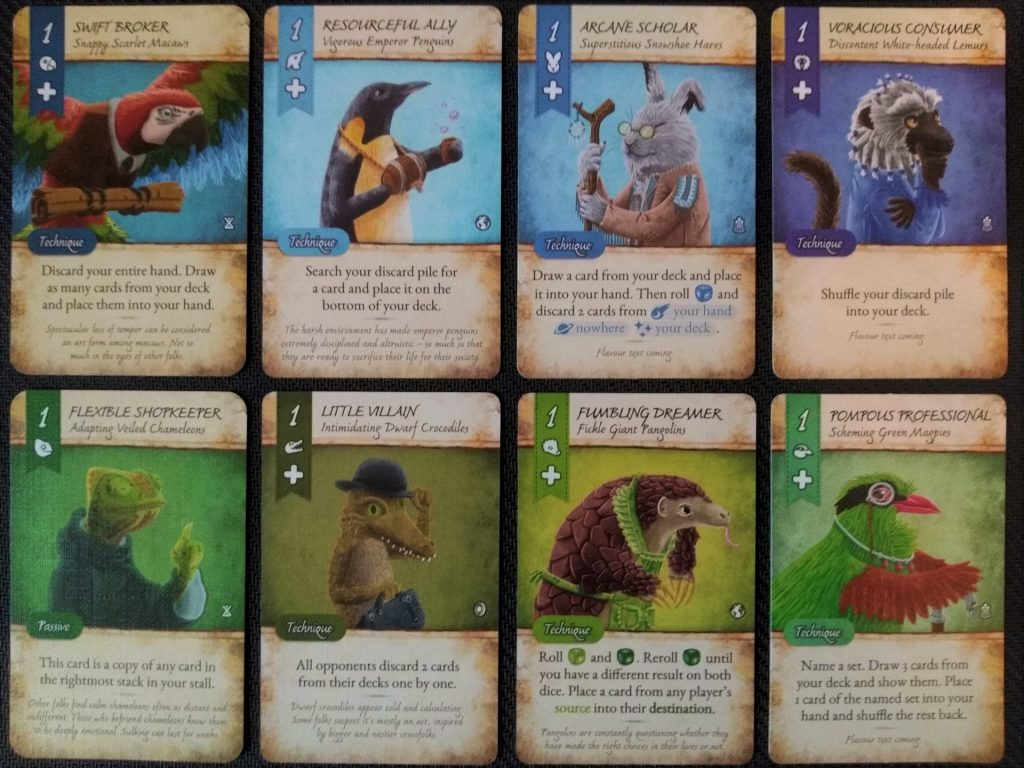
Interestingly, unlike in previous games, there are no cards that let you make use of the junk cards. It feels like there’s something missing when you think back to the Hoarding Flying Squirrels (DoM) which could build stacks using junk, or the Intimidating Dwarf Crocodiles (DoM2), Friendly Fennec Foxes (DoM2), and Swindling Black-headed Gulls (DoM Collection) which all enabled you to ‘gift’ junk cards to other players in various ways. The Tree-kangaroos’ ‘Barricade’ card lets you specifically search out junk cards, making throwing them away easier, but even that feels less junk-focussed than the ‘Housecleaning’ card from DoM2’s Diligent Pale-throated Sloths. In DoM3 the junk cards are just that – junk. Minor disappointment aside, even plain old junk has its uses sometimes and it can be important to ensure that you’ve got a junk card on top of your discard pile to protect you from those ‘sharing’ Echidnas.

Snowdale Design have also released an animalfolk deck selector tool in addition to the cards that came with DoM Collection, as well as a list of pre-selected themed sets that work well together to accentuate different experiences, from those who like to focus on the stack building to those who just want to roll dice to their heart’s content. It’s a nice touch for both the beginner and veteran of the series.
The Rise and Fall of a Deck – Animalfolk of the Game
This is subjective as it depends on your preferred playstyle but I wanted to discuss my favourite animalfolk of DoM3 because it illustrates my favourite moment in a game of DoM.
DoM games are as much about deck-dismantling as deck-building. It’s a race to place 8 stacks of cards so as much as it’s fun buying cards and working out combinations, dawdlers will lose. Whilst you want lots of cards to give you plenty of options, ending up with a large deck of cards you’ve not turned into stacks just means you’ve wasted turns buying cards you don’t need.
This creates a point in most of my games where through a combination of stack-building and deck thinning I’ve only got 5-8 cards in my deck. With so few cards you end up with a better understanding of how to use them and suddenly the route to victory clicks… or doesn’t. If you’ve trimmed the chaff from your deck too much or have decided to shift your focus to stack building too early then you’re left with a deck of cards that can’t get you where you want to go. You’ll just have to waste a few turns buying cards to get yourself back on track.
It’s a moment where the energy of your personal game changes. Your deck goes up a gear and you discover if it’ll drive you to victory or sputter and stall. It’s why I keep coming back to these games.
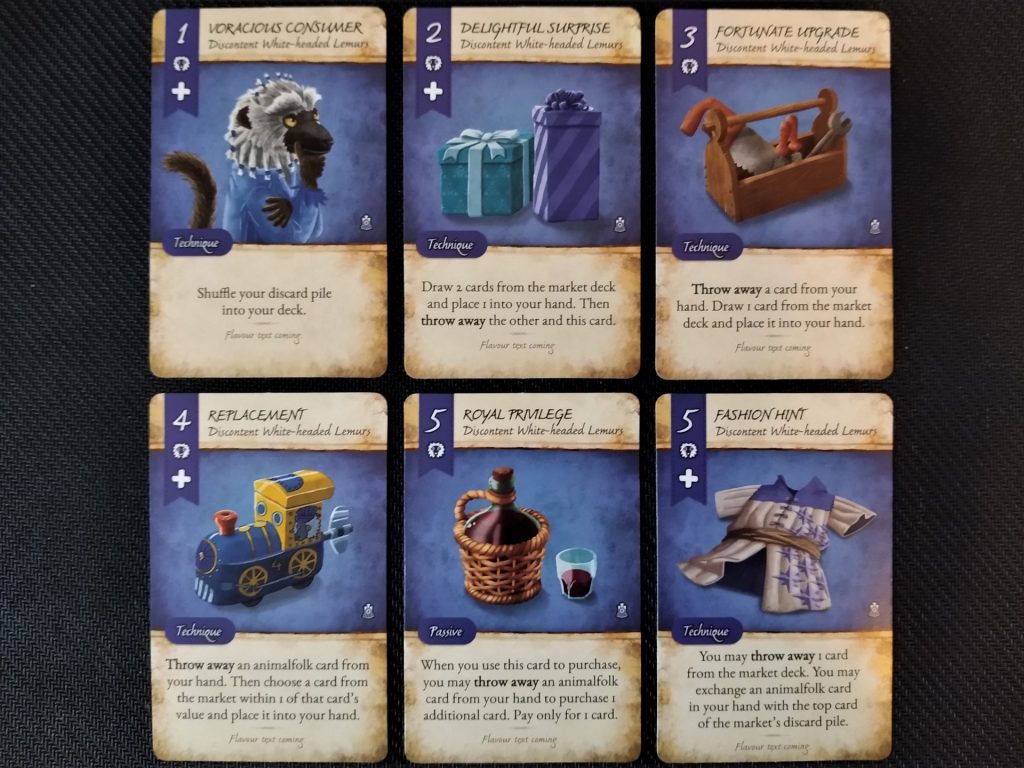
The Discontent White-headed Lemurs accentuate this feeling by constantly asking you to throw away your own cards and keep your deck lean. The Lemurs give you a lot of flexibility to switch around how your deck functions, but they also tempt you into thinning your deck too much, removing cards that may later turn out to have been invaluable. Sure, you may have complete control over how your deck drives, but did you just remove the throttle?
Keep Rolling Along – Card of the Game
There are some great cards in DoM3. The Tree-kangaroos’ ‘Supply Depot’ lets you store 2 cards for your next turn, giving you even more options and a way of bringing the very best card combinations together in a single turn. The Echidnas’ ‘Carefree Swapper’ lets you swap it with the top card of another player’s discard pile. Since it’s a 1-value card everybody starts off with ‘Carefree Swapper’ meaning that on your turn you need to consider what cards you discard and the order in which you play them. It creates a lovely additional decision space.
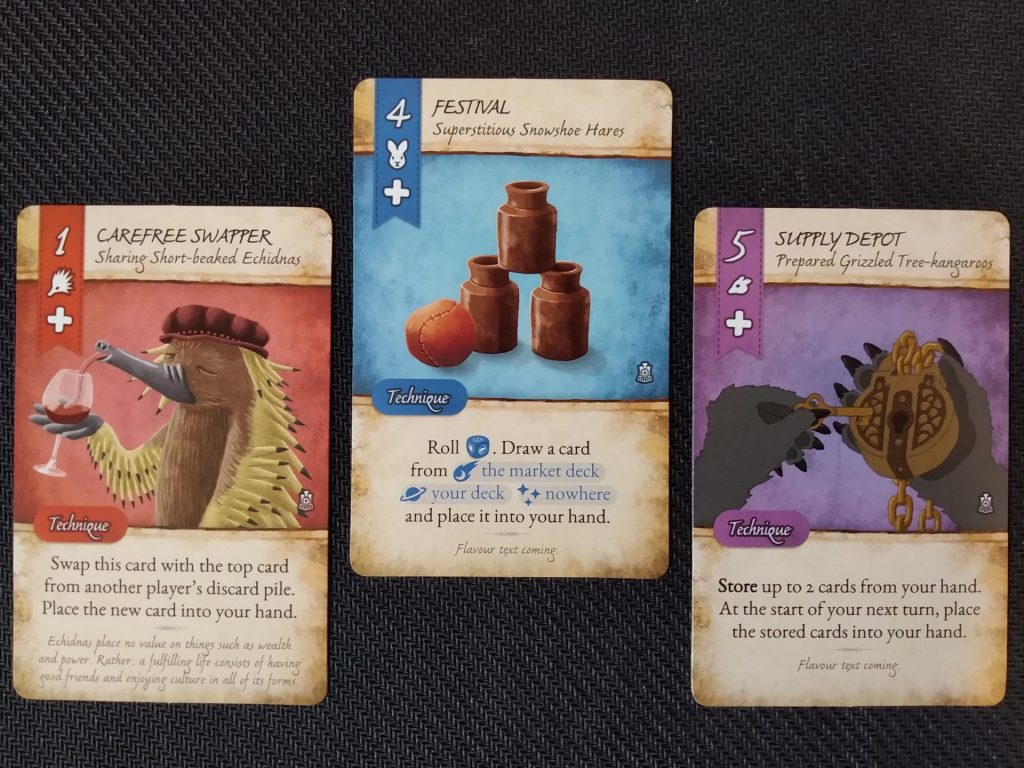
However, my standout has to be the Hares’ ‘Festival’ card which gives you the chance of getting a card from the market for free as a result of a roll of the die. It isn’t a complicated or clever card and you can end up with absolutely nothing but its simplicity is part of the appeal and it’s hard not to just take a punt when it ends up in your hand. I think ‘Festival’ might just be the best use of dice rolling in the whole series (and, for me, the Hares are possibly the best dice-rolling animalfolk so far).
Summary
DoM3 is another fantastic entry to the DoM series. By itself it gives the player a lot to think about and can be incredibly satisfying and fun. My few plays combining it with earlier animalfolk decks and character cards (from DoM Collection) suggests the new additions integrate into the existing experience seamlessly. As always the art is gorgeous, each card packed full of character, charm and humour. I don’t think DoM3 will change the mind of anyone who dislikes the series already but if you’ve not experienced DoM before then it’s a great starting point. The veteran might miss the earlier excitements of DoM Collection but repeated plays reward with depth and sophistication. An excellent addition to Snowdale Design’s stall.
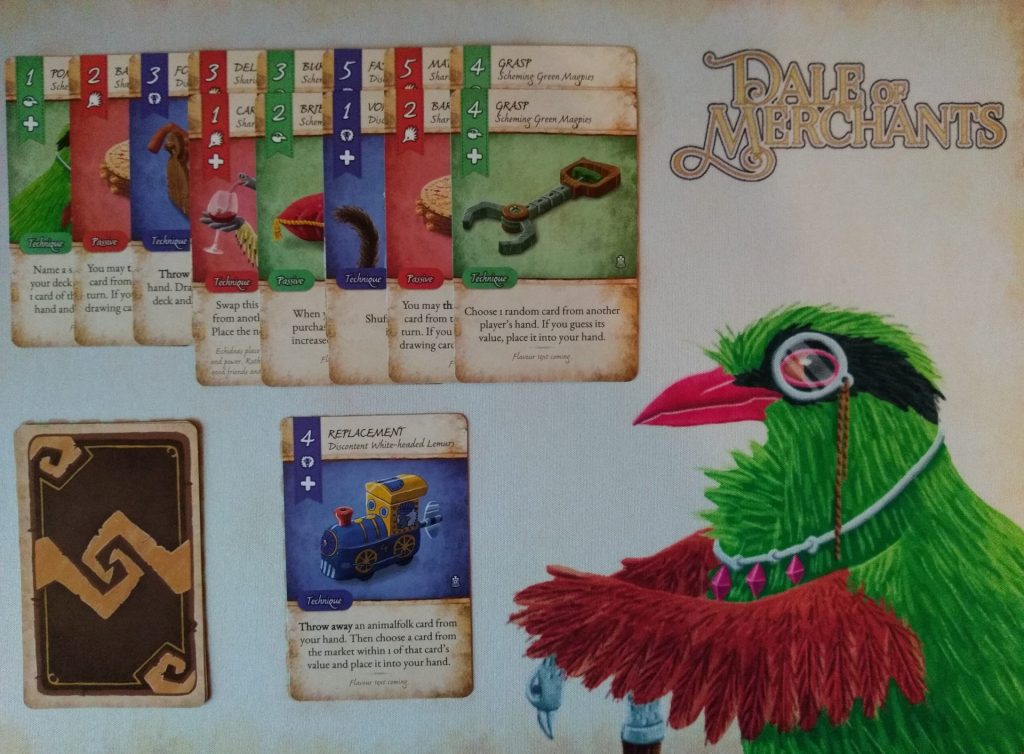
If you’re interested in the other games in the DoM series then check out Meeple Mountain’s written reviews of the original Dale of Merchants and Dale of Merchants Collection, or our video review of Dale of Merchants Collection. Dale of Merchants 3 is currently on Kickstarter here and you can find out more about the other games in the series on the Snowdale Design website.


